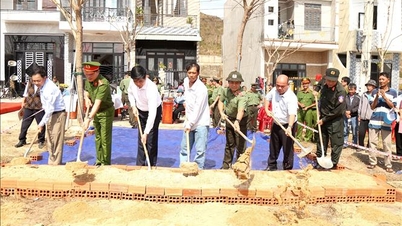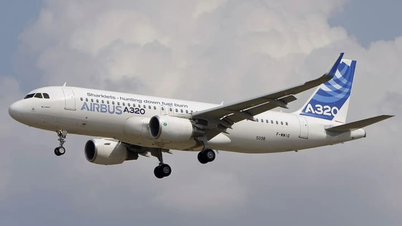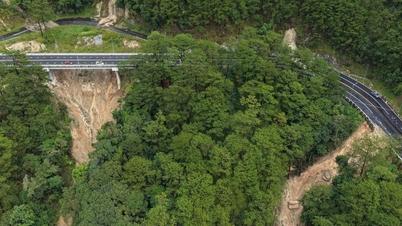The Ministry of Public Security is drafting the Law on Road Traffic Order and Safety. This law is partly separated from the 2008 Law on Road Traffic which is currently in effect.
In Article 9 of the draft regulations on general rules, the Ministry of Public Security proposes to prohibit children under 10 years old or under 1.35 m tall from sitting in the front seat of a car, and children under 4 years old must be transported in seats designed for children (except for passenger transport vehicles).
This content is completely new compared to the 2008 Road Traffic Law, because currently there are no mandatory regulations on age, height and seating position of children in cars.

It is considered safer for children to sit in the back seat of a car.
Research experiences from many countries
Colonel Nguyen Quang Nhat, Head of the Traffic Accident Investigation and Dissemination Guidance Department (Traffic Police Department, Ministry of Public Security), said the above proposal was made after the Ministry of Public Security had researched and consulted experiences from many countries around the world . "Some countries even apply a higher age," he said.
According to the Japanese colonel, children are often hyperactive, unable to protect themselves and can distract the driver. Not to mention, safety equipment in the car (seat belts, airbags, etc.) is designed for people of appropriate height, so if the child is too young, it will not be effective.
Based on the above reality, the Ministry of Public Security proposed a limit on the age and height of children sitting in the front seat of a car as well as a requirement for child safety seats. In the case of traveling by passenger transport vehicles, because children are accompanied by their parents or guardians and are protected by them while participating in traffic, the law does not regulate.
Agreeing on the need to issue regulations for children sitting in cars while participating in traffic, the Vietnam Association for the Protection of Children's Rights even proposed raising the age of children who are not allowed to sit in the front seat from 10 to 12 years old, and the age of children who must be equipped with a specialized seat from 4 to 6 years old.
Citing international studies, the Vietnam Association for the Protection of Children's Rights said that in the event of a collision, car airbags can deploy at a speed of 300 km/h. The body of an adult can withstand this impact, but young children are very vulnerable because their backs and necks are very weak. In addition, in terms of biological structure, children under 6 years old have a large head-to-body ratio, making it more difficult to maintain balance than adults, so children are prone to incorrect posture when the airbag deploys, leading to injury.
Similarly, seat belts are very effective in reducing injuries in a collision. However, seat belts are only really effective for people who are 1.48 m tall or taller. If the child is shorter, the seat belt will not hold the child's body, not only will it not be safe, but it may also cause injury from the seat belt itself.
Meanwhile, Associate Professor, Dr. Pham Viet Cuong (Center for Policy Research and Injury Prevention, University of Public Health ) cited this unit's research conducted from 2021 to present, showing that up to 22.8% of cars have children sitting alone in the front seat; 19.2% of cars have children sitting in the front seat with adults; especially, only 1.3% of cars use safety devices for children.
The above reality is very dangerous in case of an accident. Therefore, Mr. Cuong believes that it is necessary to tighten the regulations compared to the draft of the Ministry of Public Security, in the direction that children under 1.35 m tall or under 12 years old are not allowed to sit in the front seat, and must be equipped with child safety devices.
Is it difficult to punish?
Although he supports the proposal in principle, Mr. Bui Danh Lien, Vice President of the Hanoi Transport Association, expressed concern about whether the proposal of the Ministry of Public Security is feasible when applied in practice.
Firstly, with the current socio-economic conditions, not everyone has the financial ability to immediately purchase safety equipment for children when sitting in cars. In addition, with the current awareness of the law in general and traffic safety in particular, especially in remote areas, will people seriously comply?
Second, do the authorities have difficulty in checking and handling violations? Because determining the age of children is not always easy, for example, if parents do not bring their children's identification documents. Similarly, how will determining a child's height be done? If using a manual ruler, will it be accurate...?
From the above analysis, Mr. Lien affirmed that the proposal of the Ministry of Public Security is very humane and progressive but may not be suitable for immediate application at the present time. He said that propaganda work should be strengthened to raise people's awareness first, and when the socio-economic and compliance conditions are met, then the regulation will be applied. Thus, the regulation will be more feasible and effective.
From another perspective, Ms. Ha Thi Phuong (living in Hanoi) welcomed the proposal as in the draft. However, she suggested that there should be specific regulations on technical requirements, types, installation methods, etc. for chairs specifically for children. Currently, there are many chair models advertised on the market, with differences in price, design, and quality. Without specific regulations, people will have difficulty in implementing them correctly.
Colonel Nguyen Quang Nhat
Regarding whether it is difficult to punish violations, Colonel Nguyen Quang Nhat affirmed that as long as the law stipulates, the traffic police will have enough professional measures to check and handle. He reiterated that the regulation that children over 6 years old must wear helmets has also received questions about how to determine the age to punish; in reality, the authorities can still check and handle as usual.
With regulations on the age or height of children when sitting in cars, traffic police will also implement the same. "Most importantly, it is the awareness of the parents themselves. They must be aware of protecting the health and safety of their children. The ultimate goal of the regulations is to aim at this," Colonel Nhat emphasized.
Many countries apply
In the US, car seat regulations are set by each state, but all have age, height, and weight restrictions for each position and type of car seat. Some states do not allow children under 8 years old to sit next to the driver, while others allow children under 12 years old.
In the UK, the compulsory use of car seats applies to children under 12 years of age or under 1.35m tall, whichever comes first. The car seat used must be EU approved and licensed for use in the UK.
In Chile, it is illegal for children under 12 years old to ride in the front seat of cars, vans, trucks and similar vehicles. Children under 9 years old or under 1.35 m tall are required to be fitted with a safety seat.
Source link


















































































































Comment (0)